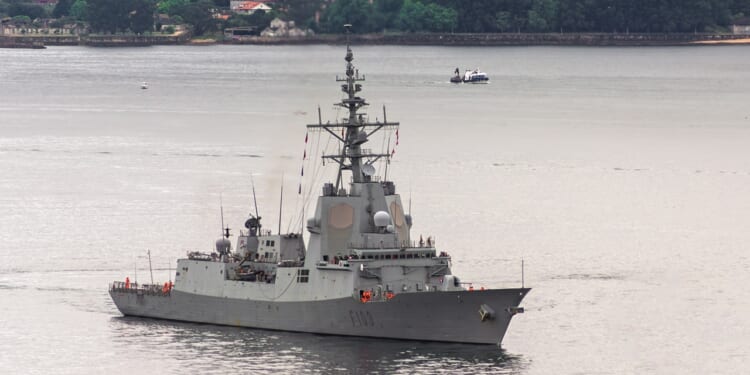The first warship is named for Admiral Pierre-Alexis Ronarc’h, who served in the French Navy during World War I. Four more are under construction for France, and three for Greece.
The Maritime Nationale (French Navy) has received its first new frigate, of a planned five in total, earlier this month. The Amiral Ronarc’h (D660) was handed over at a ceremony in Brest, near France’s westernmost point, home to the country’s second-largest naval base.
The warship, built at the French-based Naval Group defense conglomerate’s shipyard in Lorient, is the first of the “defense and intervention frigates” (Frégate de défense et d’intervention, or FDI). The new vessels will replace the French Navy’s aging La Fayette-class frigates, which first entered service in the early 1990s. When the final FDI warship is delivered in 2030, it will allow Paris to achieve its goal of having a force of 15 modern “first-rank frigates,” with the new vessels serving along with the two Horizon-class air defense frigates and the eight Aquitaine-class Frégate Européenne Multi-Mission (FREMM) ships now in service.
“The delivery of the Amiral Ronarc’h, the very first frigate in the FDI series, is a major milestone for Naval Group. This new generation of top-of-the-range multi-purpose frigates will soon enter operational service and will help to strengthen the capabilities of our French Navy thanks to its exceptional capabilities, already demonstrated during sea trials,” said Naval Group chairman and CEO Pierre Éric Pommellet. “We are fully committed to this major programme, which we are proud to be carrying out for the French Navy.”
The Admiral Ronarc’h’s Specifications
- Year Introduced: 2025
- Number Built: 1 (5 planned in class)
- Length: 122 meters (400 ft)
- Beam (Width): 18 meters (59 ft)
- Displacement: 4,500 tons
- Engines: CODAD powerplant
- Top Speed: 27 knots (31 mph, 50 km/h)
- Range: 5,000 nmi (5,753 mi, 9,260 km); 45 days’ endurance
- Armaments:
- 16 Aster surface-to-air missiles (developed by MBDA)
- Eight Exocet MM40 Block 3c anti-ship missiles (developed by MBDA)
- MU 90 torpedoes (developed by Naval Group)
- One 76 mm cannon
- Two Narwhal 20mm remote weapon stations
- Four torpedo tubes
- CANTO countermeasures (developed by Naval Group)
- Crew: 125 (110 sailors, 15 helicopter crew members); can carry 28 passengers
Why Is France Building the FDI Frigates?
The multi-role FDIs can be employed in a variety of combat operations, including anti-aircraft, anti-submarine warfare (ASW), anti-surface warfare (ASuW), and asymmetric warfare.
The defense and intervention frigates are armed with a single OTO Melara 76mm naval gun, a pair of Nexter Narwhal remotely operated 20mm autocannons, and a CANTO torpedo decoy countermeasures. The frigates can launch Aster surface-to-air missiles, Exocet anti-ship missiles, and torpedoes, and can carry an NH90 helicopter. The warships will also be able to launch and recover unmanned aerial systems (UAS).
Around two dozen special forces operators can be deployed from the frigates via the helicopter or two rigid inflatable boats for at-sea and boardings or interceptions.
The FDIs have a number of design innovations not seen on previous generations of French warships. They were designed with an inverted bow to improve seafaring, and an asymmetric warfare bridge for coordinating near-field ship self-defense. Each vessel will also be outfitted with an integrated command/sensor mast block, the Panoramic Sensors and Intelligence Module (PSIM). To counter electronic warfare (EW) and cyber warfare (CW) threats, the frigates will be equipped with a redundant IT architecture featuring twin data centers that host the onboard IT applications.
The first FDI warship is named for Admiral Pierre-Alexis Ronarc’h, who served in the French Navy during World War I. The next four frigates will be named for other French naval officers, and include the Amiral Louzeau, Amiral Castex, Amiral Nomy, and Amiral Cabanier.
In addition to the five being built for the French Navy, three FDI HN variants (also known as the Kimon class) are being produced for the Greek Navy, with the first on track to be delivered next year. Naval Group has also pitched the FDI to the navies of NATO members Denmark and Sweden, as well as to Saudi Arabia and Indonesia.
The construction of each of the FDIs supports around 1,200 Naval Group employees and more than 400 subcontractors. Construction time involves approximately one million hours of labor, along with an equal amount of time devoted to design and development.
About the Author: Peter Suciu
Peter Suciu has contributed over 3,200 published pieces to more than four dozen magazines and websites over a 30-year career in journalism. He regularly writes about military hardware, firearms history, cybersecurity, politics, and international affairs. Peter is also a contributing writer for Forbes and Clearance Jobs. He is based in Michigan. You can follow him on Twitter: @PeterSuciu. You can email the author: [email protected].
Image: Shutterstock / Rojo5.


















